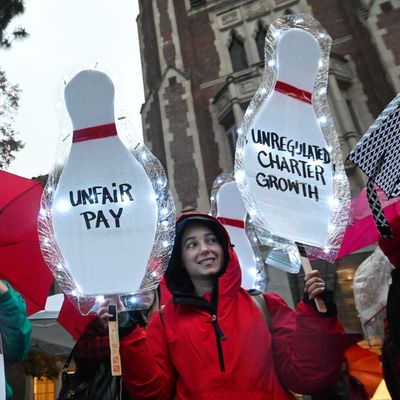
“In the four years that I’ve been teaching, I’ve seen young professional teachers like me just leave the profession because the pay and the conditions are so horrible,” said Rachael Kriete, who teaches biology and AP environmental science at Downtown Magnet High School in Los Angeles. “I will never be able to own a home in Los Angeles, if I’m a teacher. I have had to postpone having kids because the pay is so horrible here.”
This week, Kriete joined more than 30,000 other public educators in the Los Angeles United School District on the picket line. On Monday, educators represented by the United Teachers of Los Angeles called the district’s first strike in 30 years after negotiations with the LAUSD failed to produce a satisfactory contract. Affecting around 600,000 students, it’s one of the largest labor actions by teachers since a walkout by West Virginia educators in February set off a wave of teacher protests nationwide. While their contract dispute actually predates the Red for Ed movement, as the walkout wave has come to be known, L.A. teachers have adopted the movement’s red shirts and use of the #RedforEd hashtag.
Like educators in many other parts of the country, those striking in L.A. cite low pay as an important concern — particularly because their city is such an expensive place to live. However, an intense debate over charter schools distinguishes this action from other entries in the Red for Ed ledger. Educators like Kriete are deeply critical of the school district’s favorable stance toward the charter-school movement, and link their overcrowded classrooms and under-resourced campuses to a district preference for charters over traditional public schools.
The strike is thus rooted in a long-running battle over the explosive growth of charter schools in L.A. The state of California enthusiastically bought into the charter-school movement, and has become so associated with charters that its parent trigger law, which allows the parents of students to initiate a process that converts a struggling public school into a charter school, helped inspire a widely panned 2012 film starring Maggie Gyllenhaal and Viola Davis, Won’t Back Down. Six years after Won’t Back Down screened at the Democratic National Convention in Charlotte, North Carolina, Los Angeles now has 138,000 students enrolled in charter schools, the highest number in the country. UTLA now seeks to correct what they see as the city’s long-term neglect of its traditional schools. The union is calling for lower class sizes, more support staff like school counselors, librarians, and social workers, and better regulation of the city’s charter schools, which have proliferated despite high-profile cases of fraud and poor academic performance. Charter-school educators, it should be noted, have their own complaints. On Tuesday, UTLA announced unionized staff at The Accelerated Schools have declared a strike too — the nation’s second ever against a charter-school operator — and would join their peers on the picket line.
UTLA’s demands put the union sharply at odds with the LAUSD school board, which has been controlled by charter-school operators and advocates for the charter-school movement since 2017. That shift in the board’s makeup owes directly to the efforts of wealthy charter-school backers who, according to Governing magazine, spent around $9.4 million to get two new charter-affiliated officials on the board. The district’s current superintendent, Austin Beutner, is a former investment banker who briefly served as deputy mayor in 2010, under then-mayor Antonio Villaraigosa — himself a former labor organizer turned charter-school advocate who once accused UTLA of being an “unwavering roadblock to reform.” As the Washington Post reported at the time of his appointment last July, Beutner has no experience in education or school administration. Like the school board officials who appointed him, however, he does have strong links to the charter-school movement — and that worries UTLA members.
Mark Campbell, who teaches English at Benjamin Franklin High School in the Highland Park neighborhood of Los Angeles, told New York in an email last Friday that “in my 15 years of teaching, I perceive most of us have felt abandoned by our employer. We have been underfunded, underpaid, over-tested. My school currently has no heat for its teachers and 1,500 students.” Campbell, who sits on the Labor Committee of the Democratic Socialists of America’s Los Angeles chapter and is involved in his school’s union chapter, criticized Beutner for his hedge fund past. He said he believes Beutner and the LAUSD school board “have no intention of restoring, working toward a high functioning system of public education.”
Beutner has said that the strike is not “a referendum on charter schools.” But the union’s demands for better charter-school regulation and a cap on charter-school growth are related inextricably to its plea for more funding for traditional public education. A 2016 study commissioned by UTLA from MGT of America estimated that charter schools cost LAUSD around $500 million annually and that at the time, the oversight fees paid by charters to the school district did not cover the annual operating budget of the city’s charter division. One analysis of that study, produced by the Partnership for Working America’s project In the Public Interest, concluded that traditional public schools faced a net loss of $4,957 in state funds for every student that left to attend a charter school. LAUSD currently has unrestricted financial reserves of nearly $2 billion, but the district and the union remain far apart not just on the charter-school question, but on specific strategies to reduce class size, which would require LAUSD to hire more staff.
“We have been bargaining for 20 months and our big sticking points are about basic resources and the quality of the classroom and school experience. Class size is probably at the top of that list,” said Gillian Russom, who teaches U.S. history at Roosevelt High School. “I know personally I have two U.S. history classes of 40 students right now, and class sizes of over 40 are pretty common in secondary schools in L.A.”
Russom, who serves on UTLA’s board of directors, added, “We have some of the highest class sizes in the nation and we serve 85 percent black and brown students. We serve 80 percent low-income students. Our students need a lot of support to improve their skills. And it’s just not respectful of me as an educator or of them as students to think that I can give all 40 or 42 or 45 the support they really need.” Russom added that in her experience, the students who leave her classroom to attend charter schools are students who “tend to be from families where they have a little bit more time and a little bit more resources and it tends to be the higher achieving students.” In Los Angeles, severely disabled students are also much more likely to attend traditional public schools, not charters, and traditional schools therefore bear the bulk of the district’s special education costs.
UTLA is seeking to remedy the situation by demanding the removal of Section 1.5 from their contract, which caps class sizes at 39 students in most secondary schools and 33 students in most elementary schools. The same section also allows the school district to bypass those caps, and as a result, class sizes often exceed what should be the maximum allowable limit. The district’s most recent counter-proposal allocates $130 million to reduce class sizes through the hiring of new teachers and support staff, but suggests replacing Section 1.5 with a clause that revises maximum class-size caps to 46 students in some secondary schools — while still allowing the district to bypass the caps if certain economic trigger conditions are met. Jeff Good, UTLA’s executive director, told New York that the union believes the triggers are easy to meet, and would allow the district to once again bypass set class-size caps the way it has for the past two decades. “We call it Section 1.5 on steroids,” Good said.
Pedro Salcido, LAUSD’s director of policy, disputed UTLA’s characterization of the district’s proposal. “It’s factually incorrect that we want to raise class sizes,” he told New York on Monday. According to Salcido, the district’s counter-proposal revises the class-size cap to reflect current class-size averages. It would not raise class sizes, in other words, but keep them as they are — unless economic factors demand otherwise. Salcido says the triggers are open to negotiation.
“Look, we’re willing and ready to negotiate when they are,” he said. “It takes two to negotiate and we’re here and ready to do that.” But on Wednesday, as teachers walked out for a third day, chances of compromise seemed slim. The district has consistently maintained that its cash reserves are already pledged to other needs, and in a Monday Wall Street Journal editorial that omitted any mention of charter schools, Beutner argued that the district’s hands are tied until the state government allocates more funds for the school district.
Teachers, meanwhile, told New York that they dread being away from their students. But they’re prepared to stay on the picket line until they can agree on a contract, and emphasize that they’re fighting for more than better working conditions. Low pay and crowded classrooms don’t just harm teachers, after all; they undermine student learning-conditions, too.
“The district has spun this to create the public perception that once again, teachers are selfish, teachers are only out for themselves. That this strike is all about money, inconveniencing the families of the students we serve. But it is not,” Campbell, the English teacher, added. “It is about abandoning this great social leveler. UTLA teachers know the system is not perfect. We deal with it everyday. But there is no possible way, as much as we strive, to turn this situation around if the district will not join us and Beutner has no plans to do so.”
Good, UTLA’s executive director, told New York on Monday that the strike is a “righteous struggle” for the future of public education in Los Angeles. On Tuesday, UTLA members and supporters clearly identified the forces they believe they’re struggling against: Tens of thousands of educators took their protest to the headquarters of the California Charter Schools Association. Striking charter educators from The Accelerated Schools joined them.






























